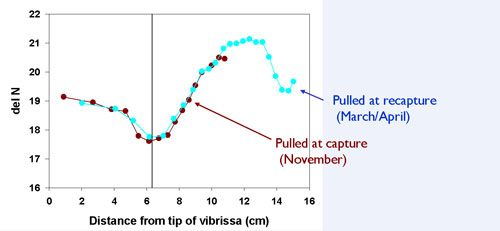Steller Sea Lion Research
Stable Isotope Analysis
Ratios of naturally occurring stable isotopes of nitrogen and carbon have been successfully used in a variety of species to provide information about food webs and diets of mammals. Nitrogen isotopes are useful to indicate trophic level (roughly analogous to an animal’s position on the “food web”) and carbon isotopes indicate differences between inshore and offshore food webs.
We use stable nitrogen to determine when young sea lions shift from a diet of mother’s milk to independently hunting for prey. This method uses the logic that suckling pups are at a higher trophic level than the mothers they are consuming milk from, and that we should expect nitrogen values to drop, indicating a drop in trophic level, post-weaning. We have examined stable nitrogen found in milk, blood and whiskers (or vibrissae), and have been able to identify a shift in the stable isotopes signatures associated with the shift from a milk diet to a fish diet. Whiskers are particularly useful because they provide an isotope record from before the animal was born (in utero deposition shown at the tip of the whisker) to the time when the whisker is collected (between 1 and 48 months of age). Thus the shift in diet appears along the length of the whisker and is represented by the shift in isotope signature. We are currently working to accurately estimate corresponding dates along the length of whiskers based on rates of whisker growth in order to better link changes in nitrogen to changes in behavior and season.

While this technique provides valuable information about the shift in diet, it cannot indicate what types of prey the sea lions are eating once they start to forage on their own. To this end, we have compiled a database of carbon/nitrogen signatures reported in the literature from known Steller sea lion prey in Alaska. We are investigating whether comparing the sea lion signatures to the prey signatures may indicate which prey items are present in an individual sea lion diet.
Publications
- Stegall, V.K., S.D. Farley, L.D. Rea, K.W. Pitcher, R.O. Rye, C.L. Kester, C.A. Stricker, and C.R. Bern. 2008. Discrimination of carbon and nitrogen isotopes from milk to serum and vibrissae in Alaska Steller sea lions (Eumetopias jubatus). Canadian Journal of Zoology 86:17–23.
Contact the ADF&G Steller Sea Lion Program at dfg.dwc.sealions@alaska.gov.
